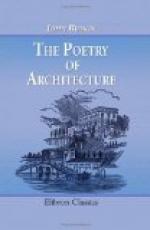92. III. The Wild, or gray, Country. “Wild” is not exactly a correct epithet; we mean wide, uninclosed, treeless undulations of land, whether cultivated or not. The greater part of northern France, though well brought under the plow, would come under the denomination of gray country. Occasional masses of monotonous forest do not destroy this character. Here, size is desirable, and massiness of form; but we must have no brightness of color in the cottage, otherwise it would draw the eye to it at three miles off, and the whole landscape would be covered with conspicuous dots. White is agreeable, if sobered down; slate allowable on the roof as well as thatch. For the rest, we need only refer to the remarks made on the propriety of the French cottage.
93. Lastly, Hill, or brown, Country. And here if we look to England alone, as peculiarly a cottage country, the remarks formerly advanced, in the consideration of the Westmoreland cottage, are sufficient; but if we go into mountain districts of more varied character, we shall find a difference existing between every range of hills, which will demand a corresponding difference in the style of their cottages. The principles, however, are the same in all situations, and it would be a hopeless task to endeavor to give more than general principles. In hill country, however, another question is introduced, whose investigation is peculiarly necessary in cases in which the ground has inequality of surface, that of position. And the difficulty here is, not so much to ascertain where the building ought to be, as to put it there, without suggesting any inquiry as to the mode in which it got there; to prevent its just application from appearing artificial. But we cannot enter into this inquiry, before laying down a number of principles of composition, which are applicable, not only to cottages, but generally; and which we cannot deduce until we come to the consideration of buildings in groups.




